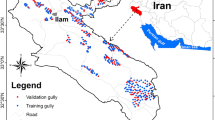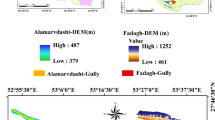Abstract
Gully erosion studies are usually complex and expensive due to the multiple nature of the causative factors, heterogeneity of the underlying geologic materials, and the high volume of point source data required within a given area. For this reason, thorough gully erosion studies are rarely carried out, especially in developing countries with few resources allocated to environmental studies. Thus, it becomes difficult in solving problems arising from such a geologic hazard in those areas. However, the availability of data emanating from remotely sensed operations can be utilized in solving complex gully erosion problems using modern geospatial analytical tools. Consequently, a gully erosion susceptibility study was carried out in Anambra State, Southeastern Nigeria, by integrating remotely acquired geomorphologic and environmental data with the geotechnical information that was derived from field and laboratory investigations. The integrated geomorphologic, environmental, and geotechnical data were analysed with analytical tools such as ArcGIS, Google Earth, and Microsoft Excel, following the frequency ratio method. Results from the study revealed that slope angle, soil plasticity, angle of internal friction, cohesion, and population density contributed about 20%, 23%, 20%, 18%, and 9%, respectively, to soil’s susceptibility to gullying. Slope angle positively correlated with the frequency of gully erosion, whereas population density, plasticity, cohesion, and angle of internal friction negatively correlated with the frequency of gully erosion. The spatial distribution of the data revealed areas that are susceptible to gullying in their various degrees, thus providing affordable information for proper environmental planning and development.


















Similar content being viewed by others
Data availability
The datasets generated during and/or analysed during the current study are available from the corresponding author upon reasonable request.
References
Akpokodje EG, Tse AC, Ekeocha N (2010) Gully erosion geohazards in south-eastern Nigeria and management implications. Sci Afr 9(1):20–36
Arua I, Rao VR (1987) New stratigraphic data on the Eocene Ameki Formation, south-eastern Nigeria. J Afr Earth Sci 6(4):391–397
ASTM D2487–11 (2011) Standard practice for classification of soils for Engineering purposes (Unified Soil Classification System). ASTM International, West Conshohocken, PA, p 04.08
ASTM D3080–04 (2004) Standard test method for direct shear test of soils under consolidated drained conditions
Begy RC, Savin CF, Kelemen S, Veres D, Muntean OL, Malos CV et al (2021) Investigation of the effect of anthropogenic land use on the Pănăzii Lake (Romania) catchment area using Cs-137 and Pb-210 radionuclides. PLoS ONE 16(6):e0251603. https://doi.org/10.1371/journal.pone.0251603
Brunori F, Penzo MC, Torri D (1989) Soil shear strength: its measurement and soil detachability. CATENA 16:59–71
Bühmann C, Escott BJ, Hughes JC (2004) Soil mineralogy research in South Africa, 1978 to 2002—a review. South Afr J Plant Soil 21(5):316–329. https://doi.org/10.1080/02571862.2004.10635067
Chen XL, Ran HL, Yang WT (2012) Evaluation of factors controlling large earthquake-induced landslides by the Wenchuan earthquake. Nat Hazard 12(12):3645–3657
Dim CIP (2021) Facies Analysis and Interpretation in Southeastern Nigeria’s Inland Basins. Springer Briefs in earth sciences. Springer International Publishing, p 73
Djeddaoui F, Chadli M, Gloaguen R (2017) Desertification susceptibility mapping using logistic regression analysis in the Djelfa area. Algeria Remote Sens 9:1031. https://doi.org/10.3390/rs9101031
Egashlra K, Kaetsu Y, Takuma K (1983) Aggregate stability as an index of erodibility of Ando soils. Soil Sci Plant Nutr 29(4):473–481
Egboka BCE, Nwankwor GI, Orajaka IP (1990) Implications of paleo-and neotectonics in gully Erosion prone area of south eastern Nigeria. Nat Hazards J 3:219–231
Egbueri JC, Igwe O (2020) Development of a novel numerical indicator (DLPI) for assessing the detachability and liquefaction potentials of soils in erosion-prone areas. Model Earth Syst Environ. https://doi.org/10.1007/s40808-020-00999-0
Egbueri JC, Igwe O (2021) The impact of hydrogeomorphological characteristics on gullying processes in erosion-prone geological units in parts of southeast Nigeria. Geol, Ecol, Landsc 5(3):227–240. https://doi.org/10.1080/24749508.2020.1711637
Egbueri JC, Igwe O, Unigwe CO (2021) Gully slope distribution characteristics and stability analysis for soil erosion risk ranking in parts of southeastern Nigeria: a case study. Environ Earth Sci 80:292. https://doi.org/10.1007/s12665-021-09605-7
Emeh C, Igwe O (2017) Variations in soils derived from an erodible sandstone formation and factors controlling their susceptibility to erosion and landslide. J Geol Soc India 90(3):362–370
Emeh C, Igwe O (2018) Effect of environmental pollution on susceptibility of sesquioxide-rich soils to water erosion. Geol, Ecol, Landsc. https://doi.org/10.1080/24749508.2018.1452484
Eze HI (2007) Effect of rain fall intensity and energy on gully development in North eastern Enugu state Nigeria. Niger J Technol 26(1):91–96
Fabijańczyk P, Zawadzki J, Magiera T (2017) Magnetometric assessment of soil contamination in problematic area using empirical Bayesian and indicator kriging: a case study in Upper Silesia Poland. Geoderma 308:69–77
Fenta AA, Tsunekawa A, Haregeweyn N et al (2021) Agroecology-based soil erosion assessment for better conservation planning in Ethiopian river basins. Environ Res 195:110786. https://doi.org/10.1016/j.envres.2021.110786
Hill KM (2010) Understanding environmental pollution, 3rd edn. Cambridge University Press, New York, p 562
Horner RR, Skupien JJ, Livingston EH, Shaver HE (1994) Fundamentals of urban runoff management: technical and institutional issues. Terrene Institute, Washington, D.C.
Ifeka A, Akinbobola A (2015) Trend analysis of precipitation in some selected stations in Anambra State. Atmos Clim Sci 5:1–12
Igbozurike UM (1993) Soil erosion prevention and control manual. Frieddrich Ebert Foundation Publishers, London, p 31
Igwe CA (2005) Erodibility in relation to water-dispersible clay for some soils of Eastern Nigeria. Land Degrad Dev 16:87–96
Igwe O, Fukuoka H (2015) The effect of water saturation on the stability of problematic slopes at Iva valley area, Southeast Nigeria. Arab J Geosci 8:3223–3233
Igwe O, Sassa K, Wang FW (2007) The influence of grading on the shear behavior of loose sands in stress-controlled ring shear tests. Landslides. J Int Consort Landslides 4(1):43–51
Igwe O, Mode W, Okechukwu N, Ikenna O, Oha I (2013) The analysis of rainfall-induced slope failure at Iva valley area of Enugu state Nigeria. Environ Earth Sci. https://doi.org/10.1007/s12665-013-264-x
Ijioma MA (1988) A conceptual ecosystems models for effective gully erosion management: a case study of the Onu-Igbere gully. In: Proc. Int. Symp. On Erosion in S.E. Nigeria, p 92–97
Kokusho T, Hara T, Hiraoka R (2004) Undrained shear strength of granular soils with different particle gradations. J Geotech Geoenviron Eng, ASCE 130(6):621–629
Laker MC (2004) Advances in soil erosion, soil conservation, land suitability evaluation and land use planning research in South Africa, 1978–2003. South Afr J Plant Soil 21(5):345–368
Lee S, Sambath T (2006) Landslide susceptibility mapping in the Damrei Romel area, Cambodia using frequency ratio and logistic regression models. Environ Geol 50(6):847–855
National Bureau of Statistics (2020) Demographic Statistics bulletin. Retrieved from https://www.nigerianstat.gov.ng/. Accessed 12 November, 2020
Nnadi OI, Liwenga ET, Lyimo JG, Madukwe MC (2019) Impacts of variability and change in rainfall on gender of farmers in Anambra. Southeast Niger Heliyon 5(7):E02085. https://doi.org/10.1016/j.heliyon.2019.e02085
Nwajide SC (1979) A lithostrtigraphic analysis of the Nanka sands of southeastern Nigeria. J Min Geol 16(2):103–109
Nwazelibe VE, Unigwe CO, Egbueri JC (2022) Integration and comparison of algorithmic weight of evidence and logistic regression in landslide susceptibility mapping of the Orumba North erosion-prone region Nigeria. Model Earth Syst Environ. https://doi.org/10.1007/s40808-022-01549-6
Obi GC, Okogbue CO (2004) Sedimentary response to Tectonism in the Campanian-Maastrichtian succession, Anambra Basin, Southeastern Nigeria. J Afr Earth Sci 38:99–108
Oboh-Ikuenobe FE, Obi GC, Jamarillo CA (2005) Lithofacies, palynofacies and sequence stratigraphy of paleogene strata in Southeastern Nigeria. J Afri Earth Sci 41:79–101
Okagbue CO, and Uma KO (1987) Performance of gully erosion control measures in South-eastern Nigeria. In: Proceeding of the International Symposium on Forest Hydrology and Watershed Management. IAHS Publication, Vancouver, Canada. pp 163-172
Olaniya M, Bora PK, Das S (2020) Soil erodibility indices under different land uses in Ri-Bhoi district of Meghalaya (India). Sci Rep 10:14986. https://doi.org/10.1038/s41598-020-72070-y
Onwo ES, Emeh C, Igwe O (2022) Effect of geochemical composition of lateritic soils on their geotechnical properties. Indian Geotech J. https://doi.org/10.1007/s40098-022-00628-w
Ozioko HO, Igwe O (2020) GIS-based landslide susceptibility mapping using heuristic and bivariate statistical methods for Iva Valley and environs Southeast Nigeria. Environ Monit Assess 192:119. https://doi.org/10.1007/s10661-019-7951-9
Roose E (1996) Land husbandry - Components and strategy. Food and Agriculture Organization of the United Nations, Rome. https://www.fao.org/3/t1765e/t1765e00.htm#Contents. Accessed 10 October, 2020
Séguret S, Huchon P (1990) Trigonometric kriging: a new method for removing the diurnal variation from geomagnetic data. J Geophys Res 32(B13):21.383-21.397
Sharma S, Mahajan AK (2018) A comparative assessment of information value, frequency ratio and analytical hierarchy process models for landslide susceptibility mapping of a Himalayan watershed India. Bull Eng Geol Environ. https://doi.org/10.1007/s10064-018-1259-9
Sharma LK, Umrao RK, Singh R, Ahmad M, Singh TN (2016) Geotechnical characterization of road cut hill slope forming unconsolidated geo-materials: a case study. Geotech Geol Eng, Online. https://doi.org/10.1007/s10706-016-0093-8
Smith HJ (1999) Application of empirical soil loss models in Southern Africa—a review. S Afr J Plant Soil 16:158–163
Unigwe CO, Igwe O, Onwuka OS, Egbueri JC, Omeka ME (2022) Roles of hydro-geotechnical and slope stability characteristics in the erosion of Ajali and Nanka geologic formations in southeastern Nigeria. Arab J Geosci 15:1492. https://doi.org/10.1007/s12517-022-10771-6
Wackernagel H (2003) Multivariate geostatistics: an introduction with applications, 3rd edn. Springer-Verlag, Berlin
Wang G, Sassa K (2001) Factor affecting the rainfall-induced flowslides in laboratory flume tests. Geotechnique 51(7):587–599
Zhang B, Zhao QG, Horn R, Baumgart T (2001) Shear strength of surface soil as affected by soil bulk density and soil water content. Soil till Res 59:97–106
Zhao B, Zhang L, Xia Z, Xu W, Xia L, Liang Y, Xia D (2019) Effects of rainfall intensity and vegetation cover on erosion characteristics of a soil containing rock fragments slope. Adv Civil Eng 2019:14. https://doi.org/10.1155/2019/7043428. (Article ID 7043428)
Ziadat FM, Taimeh AY (2013) Effect of rainfall intensity, slope, land use and antecedent soil miosture on soil erosion in an arid environment. Land Degrad Dev 24:582–590
Acknowledgements
The authors are grateful to Mr. Michael and Mr. Kazeem of the Nigerian geological survey agency for providing laboratory assistance. They are also grateful to Mr. Idris and Ms. Chidinma for providing assistance during the fieldwork and to Ms. Anulika for proofreading and improving the English language quality of this work.
Funding
No funds, grants, or other support were received. Also, all authors certify that they have no affiliations with or involvement in any organization or entity with any financial interest or non-financial interest in the subject matter or materials discussed in this manuscript.
Author information
Authors and Affiliations
Contributions
All authors contributed to the study’s conception and design. Material preparation, data collection, and analysis were performed by EC, OI, and UT Anthony Silas. The first draft of the manuscript was written by EC, and all authors commented on previous versions of the manuscript. All authors read and approved the final manuscript.
Corresponding author
Ethics declarations
Conflict of interest
The authors declare that there is no conflict of interest.
Additional information
Publisher's Note
Springer Nature remains neutral with regard to jurisdictional claims in published maps and institutional affiliations.
Rights and permissions
Springer Nature or its licensor (e.g. a society or other partner) holds exclusive rights to this article under a publishing agreement with the author(s) or other rightsholder(s); author self-archiving of the accepted manuscript version of this article is solely governed by the terms of such publishing agreement and applicable law.
About this article
Cite this article
Emeh, C., Igwe, O. & Ugwoke, T.A.S. Geospatial analysis of factors driving gully erosion: a case study from Southeastern Nigeria. Nat Hazards 117, 2903–2933 (2023). https://doi.org/10.1007/s11069-023-05971-6
Received:
Accepted:
Published:
Issue Date:
DOI: https://doi.org/10.1007/s11069-023-05971-6




